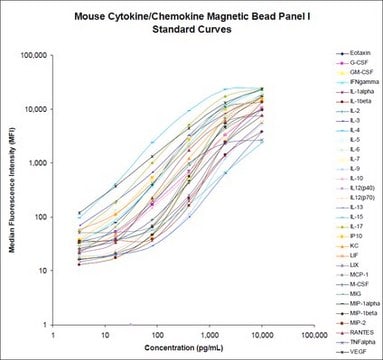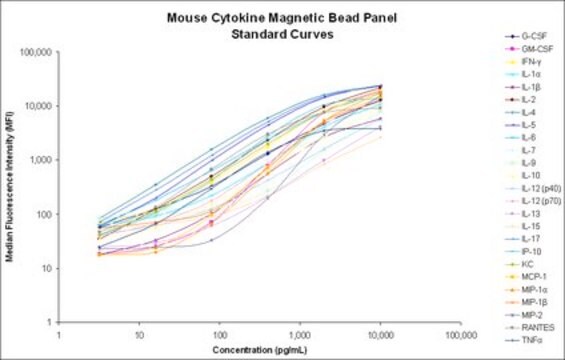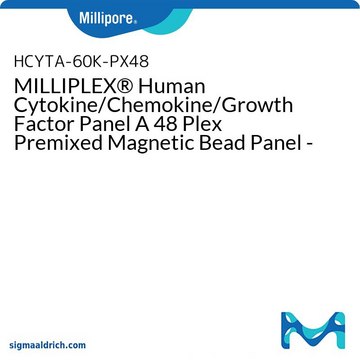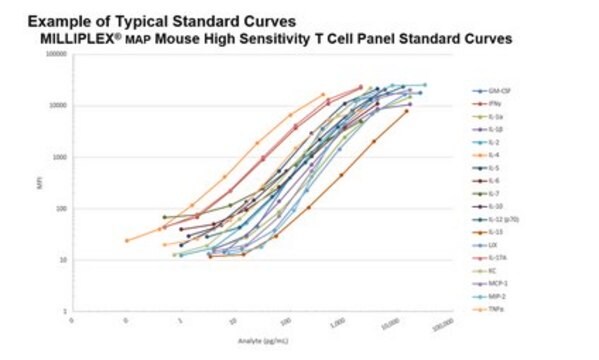MCYTMAG-70K-PX32
MILLIPLEX® Mouse Cytokine/Chemokine Magnetic Bead Panel - Premixed 32 Plex - Immunology Multiplex Assay
Simultaneously analyze multiple cytokine and chemokine biomarkers with Bead-Based Multiplex Assays using the Luminex technology, in mouse serum, plasma and cell culture samples.
Sinónimos:
Luminex® Mouse cytokine immunoassay, Millipore Mouse cytokine immunoassay, Mouse cytokine Multiplex Assay
About This Item
Productos recomendados
Nivel de calidad
reactividad de especies
mouse
fabricante / nombre comercial
Milliplex®
assay range
accuracy: 85-107%
standard curve range: 3.2-10,000 pg/mL
técnicas
multiplexing: suitable
compatibilidad
configured for Premixed
método de detección
fluorometric (Luminex xMAP)
Condiciones de envío
wet ice
Descripción general
To identify specific cytokines involved in any inflammatory or immune response, it might be necessary to screen panels of cytokines, often requiring some level of automation and/or high throughput. Beads can make the process of automation and high throughput screening easier with features such as walk-away washing. Advantages even outside automation include:
More flexible plate and plate washer options
- Improved performance with turbid serum/plasma samples
- Assay results equivalent to non- beads
- Automated washing avoids many problems associated with vacuum filtration washing
MILLIPLEX® Mouse Cytokine / Chemokine panel enables you to focus on the therapeutic potential of cytokines as well as the modulation of cytokine expression. Coupled with the Luminex® xMAP® platform in a bead format, you receive the advantage of ideal speed and sensitivity, allowing quantitative multiplex detection of dozens of analytes simultaneously, which can dramatically improve productivity.
Panel Type: Cytokines/Chemokines
Especificidad
Cross-reactivity between the antibodies and any of the other analytes in this panel is non-detectable or negligible.
Aplicación
- Analytes: Eotaxin/CCL11, G-CSF, GM-CSF, IFN-γ, IL-1α, IL-1β, IL-2, IL-3, IL-4, IL-5, IL-6, IL-7, IL-9, IL-10, IL-12 (p40), IL-12 (p70), IL-13, IL-15, IL-17, IP-10, KC, LIF, LIX, MCP-1, M-CSF, MIG, MIP-1α, MIP-1β, MIP-2, RANTES, TNF-α, VEGF
- Recommended Sample type: plasma, serum, or cell culture supernatant
- Recommended Sample dilution: 1:2 diluted plasma or serum
- Assay Run Time: Overnight or one day. For best results an overnight incubation is recommended.
- Research Category: Inflammation & Immunology
Envase
Almacenamiento y estabilidad
Otras notas
Información legal
Cláusula de descargo de responsabilidad
Palabra de señalización
Danger
Frases de peligro
Consejos de prudencia
Clasificaciones de peligro
Acute Tox. 4 Dermal - Acute Tox. 4 Inhalation - Acute Tox. 4 Oral - Aquatic Chronic 2 - Eye Dam. 1 - Skin Sens. 1 - STOT RE 2
Órganos de actuación
Respiratory Tract
Código de clase de almacenamiento
10 - Combustible liquids
Certificados de análisis (COA)
Busque Certificados de análisis (COA) introduciendo el número de lote del producto. Los números de lote se encuentran en la etiqueta del producto después de las palabras «Lot» o «Batch»
¿Ya tiene este producto?
Encuentre la documentación para los productos que ha comprado recientemente en la Biblioteca de documentos.
Nuestro equipo de científicos tiene experiencia en todas las áreas de investigación: Ciencias de la vida, Ciencia de los materiales, Síntesis química, Cromatografía, Analítica y muchas otras.
Póngase en contacto con el Servicio técnico










